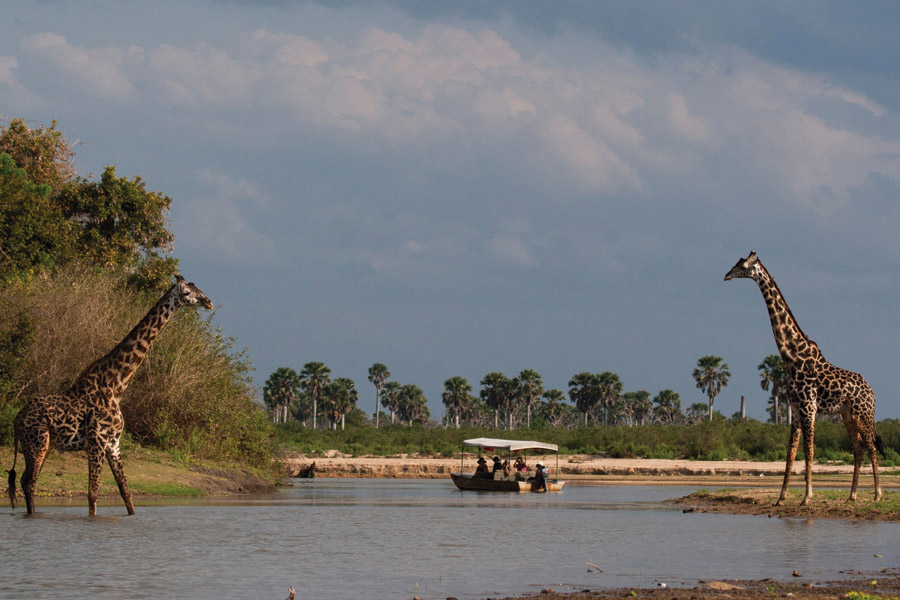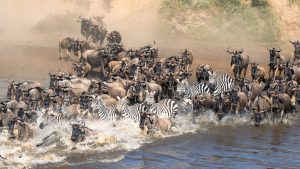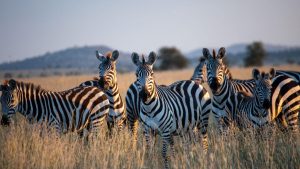Quick Facts
About Nyerere National Park
Peak Time
June - October
Best Time To Go
Year-Round
Famous For
One of Africa’s largest wilderness areas and boat safaris
Home Of
Elephants, hippos, crocodiles, and African wild dogs
Overview
Nyerere National Park, once called Selous Game Reserve, sprawls across over 30,000 square kilometers in southern Tanzania, staking its claim as one of Africa’s wildest and most expansive untamed frontiers. For safari-goers craving a road less traveled, this park is a goldmine—its sheer scale and thriving biodiversity drawing in wildlife buffs eager to spot elephants, hippos, crocodiles, and the rare African wild dog. What really makes Nyerere stand out, though, is the chance to glide through the Rufiji River and its winding channels on a boat safari, where the water’s edge buzzes with life. Which part of this hidden gem—the vast wilderness or the river adventure—grabs your attention most?

Wildlife
Nyerere National Park is a wildlife jackpot, its mix of woodlands, grasslands, and wetlands creating a playground for an incredible cast of creatures. You’ve got hefty elephant herds roaming alongside lions, leopards, giraffes, zebras, and buffaloes, all thriving in this vast expanse. The Rufiji River and its snaking tributaries steal the show, teeming with hippos and crocodiles—perfect for what’s hands-down one of Africa’s top boat safari experiences. It’s also a rare sanctuary for the endangered African wild dog, a carnivore fighting to hold its ground. And for bird lovers, the park’s a dream with over 440 species, from the elusive Pel’s fishing owl to dazzling kingfishers lighting up the scene. What’s got you most hooked—tracking wild dogs, cruising the river, or chasing those birds?
Boat Safaris on the Rufiji River
Nyerere National Park’s boat safaris are a game-changer, setting it apart with a front-row seat to the wild via the sprawling Rufiji River system. Winding through channels, lagoons, and sandbanks, you get a fresh angle on the action—hippos lounging in the shallows, crocodiles soaking up sun on the banks, and a parade of birds like fish eagles and herons stealing the sky. It’s not just a serene way to soak in the park’s beauty; it’s a photographer’s dream, with wildlife practically posing for those close-up shots. What part of this waterborne adventure—snapping pics or just drifting through the calm—sounds most up your alley?
Scenic Landscapes
Nyerere National Park’s landscapes are a feast for the eyes, rolling out a wild mix of open grasslands, acacia-dotted woodlands, thick forests, and sprawling wetlands. The Rufiji River runs the show, carving its way through with a web of lakes and channels that pull in wildlife like a magnet. Come the green season, those rains turn the riverbanks and floodplains into a lush, jaw-dropping paradise. Whether you’re drifting along the Rufiji on a boat or bouncing through the savannah on a game drive, the scenery here sticks with you long after you’ve left. What’s calling to you more—the river’s watery allure or the wide-open savannah vibes?
Activities
Nyerere National Park packs a punch with a lineup of activities that cement its status as one of Africa’s most distinctive safari spots:
- Boat Safaris: Slip along the Rufiji River for a front-row view of the wild, catching hippos, crocodiles, and a flurry of birds from an angle you won’t get anywhere else.
- Game Drives: Roam the park’s sprawling wilderness in a classic safari rig, tracking down elephants, lions, and the elusive African wild dog amid the untamed expanse.
- Walking Safaris: Hit the ground with a guide for an up-close look at the bush’s hidden gems—think animal tracks, buzzing insects, and face-to-face wildlife moments.
- Bird Watching: With over 440 species, including the rare Pel’s fishing owl, it’s a bird lover’s playground waiting to be explored.
- Fishing: Cast a line into the Rufiji River for some catch-and-release action, targeting feisty tigerfish and hefty catfish in a thrill all its own.

Inspired by What You See? Let’s Bring Your Journey to Life!
Best Time to Visit
The prime time to hit Nyerere National Park is the dry season, June to October, when wildlife clusters around water sources and thinner vegetation makes spotting them a breeze. That said, the park’s open year-round, and the green season—November to May—brings its own charm with lush, vivid landscapes, quieter trails, and top-notch bird watching as migratory flocks roll in. Boat safaris really shine in the dry months, with animals crowding the riverbanks for a drink, turning the waterways into a wildlife hotspot. Which season’s vibe—dry and action-packed or green and serene—sounds like your kind of safari?
Accommodation
Nyerere National Park serves up a spectrum of places to stay, from plush lodges perched above the Rufiji River to cozy tented camps tucked deep in the wild. Whether you’re after top-tier comfort or a rugged, nature-hugging escape, there’s something to fit the bill—each spot keeping you just a hop away from game drives and boat safaris. What kind of retreat—riverfront luxury or bush camp vibes—do you see yourself kicking back in?
Why Visit Nyerere National Park
Nyerere National Park stands tall as one of Africa’s top-tier wild havens, blending untouched, rugged landscapes with wildlife encounters that hit different. Whether you’re skimming the Rufiji River on a boat safari or shadowing African wild dogs on a guided trek, it’s a safari experience that breaks the mold. With its massive sprawl, varied habitats, and teeming animal life, it’s a magnet for anyone craving a raw, intimate bond with nature and a quieter, less-trodden path.




